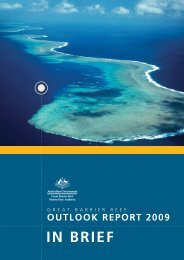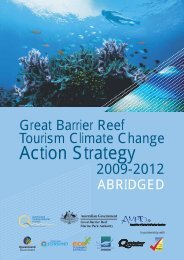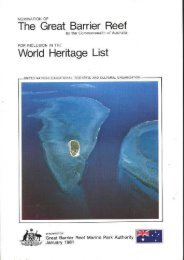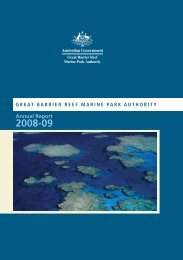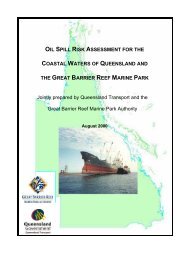Coral Bleaching Response Plan - Great Barrier Reef Marine Park ...
Coral Bleaching Response Plan - Great Barrier Reef Marine Park ...
Coral Bleaching Response Plan - Great Barrier Reef Marine Park ...
Create successful ePaper yourself
Turn your PDF publications into a flip-book with our unique Google optimized e-Paper software.
<strong>Great</strong> <strong>Barrier</strong> <strong>Reef</strong> <strong>Coral</strong> <strong>Bleaching</strong> <strong>Response</strong> <strong>Plan</strong> 2005/2006<br />
the reef system? including mortality/recovery (transects/quadrats) taxonomic resolution<br />
(transects/quadrats)<br />
• Transects include other macroinvertebrates<br />
• Fish abundance and diversity<br />
surveys<br />
E.<br />
Are adjacent human<br />
impacts causing or<br />
exacerbating the<br />
bleaching?<br />
E1<br />
• Note location, timing (onset,<br />
duration, cessation) and<br />
severity of local human<br />
impacts<br />
• Ask other reef users to give<br />
you similar information<br />
E2<br />
• Collect information on key<br />
environmental variables at<br />
impacts sites (turbidity,<br />
sedimentation, gross pollution<br />
indicators)<br />
E3<br />
• Detailed surveys at control and<br />
impact sites<br />
• Collate existing data on human<br />
impacts such as water quality,<br />
chronic disturbance from<br />
destructive fishing<br />
2. Early Warning System<br />
Mass coral bleaching is preceded by a series of stages. Beginning with the build-up of climatic<br />
conditions that warm sea temperatures, above-average water temperatures follow, which in turn can<br />
lead to patchy bleaching or bleaching of more vulnerable coral species. If stressful conditions persist,<br />
widespread bleaching of a range of coral species can ensue, resulting in a mass bleaching event. The<br />
onset of each of these stages can be used the to provide an early warning of a mass bleaching event.<br />
The GBRMPA Early Warning System consists of three elements designed to detect the onset of each of<br />
the three stages that lead to a mass coral bleaching event:<br />
1. Climate Monitoring: Development of weather conditions that are conducive to elevated sea<br />
temperatures;<br />
2. Sea Temperature Monitoring: Persistence of increased sea temperatures to levels known to cause<br />
stress to corals; and<br />
3. BleachWatch: Early signs of bleaching on reefs and the spatial extent and severity of any bleaching.<br />
2.1 Climate Monitoring<br />
Above-average sea temperatures are associated with El Niño conditions in many reef regions around the<br />
world. While the El Niño Southern Oscillation is an important influence on weather patterns over<br />
eastern Australia, other factors are also known to result in high sea temperatures in the GBR region. In<br />
particular, delayed or weak development of the monsoonal trough over northern Australia during<br />
summer appears to be a strong precursor to the anomalously warm conditions that cause stress to corals.<br />
Based on an emerging understanding of the relationship between weather and sea temperatures for the<br />
GBR, current and forecast weather conditions can provide a useful indicator of pending warming of<br />
waters in the GBR, and thus serve as early warnings of potential stress.<br />
Seasonal climate predictions will be reviewed in the early stages of summer to monitor the development<br />
of regional weather patterns that may lead to anomalous sea temperatures. These will be complemented<br />
with long- to mid-range weather forecasts as the summer progresses.<br />
Objectives: Monitor climate and weather conditions in the lead up to summer to assess risk of<br />
elevated sea temperatures<br />
Strategies: • Monitor long-range climate predictions and weather forecasts<br />
• Obtain 4-Day forecasts and weather summaries from the Bureau of Meteorology<br />
• Explore value of long-range forecast for predicting potential warming conditions<br />
Triggers: Forecasts of calm clear conditions, above average summer temperatures, or below<br />
average rainfall will trigger logistic preparations for the <strong>Bleaching</strong> Assessment and<br />
Monitoring component<br />
Climate Change <strong>Response</strong> Programme - GBRMPA 3





